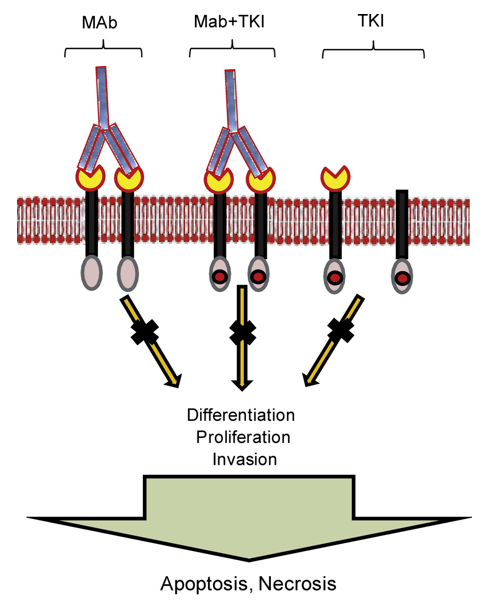
Our promise to you:
Guaranteed product quality, expert customer support.
 24x7 CUSTOMER SERVICE
24x7 CUSTOMER SERVICE
 CONTACT US TO ORDER
CONTACT US TO ORDER
ROR1 Gene Editing 
Receptor tyrosine kinase (RTK)-like orphan receptor 1 (ROR1) is an important oncofetal protein in normal embryonal development. The structure of human ROR1 possesses one FZ (frizzled) domain, one Ig-like C2-type (immunoglobulin-like) domain, one protein kinase domain and one kringle domain. After birth, ROR1 is largely downregulated, and ROR1 is present to a lesser extent in adult tissue. However, ROR1 is overexpressed in a variety of blood and solid malignancies, and its overexpression is associated with aggressive disease and poor prognosis. Negligible expression of ROR1 in normal adult tissue and overexpression in malignancies has attracted attention in the field of cancer biology and targeted therapy.
ROR1 Expression in Malignancies
The main mechanisms leading to aberrant RTK activation in human cancers are self-activation, overexpression, chromosomal translocations, gain-of-functional mutations or loss-of-function of tumor suppressor genes. Mutation analysis of the extracellular and cytoplasmic kinase domain of the ROR1 gene in chronic lymphocytic leukemia (CLL) cells indicated no major genomic aberrations. FISH analysis showed no rearrangement in the ROR1 locus. Current evidence may suggest that ROR1 acts as a classical RTK in cancer, but ROR2 might have a dual function, both as an oncogene and as a suppressor gene depending on the malignancy. ROR1 was shown to be overexpressed not only in CLL, but also in acute lymphocytic leukemia (ALL), breast cancer, lung adenocarcinoma, renal cell carcinoma, melanoma, and other lymphoid and myeloid malignancies. ROR1 has also been suggested to be associated with epithelial-mesenchymal transition (EMT) during embryogenesis and in cancer metastases. ROR1 was highly expressed in breast adenocarcinomas with high levels of a gene signature for EMT and a high rate of relapse as well as the capacity to metastasize compared to breast cancer patients with a better prognosis where the level of ROR1 expression was low.
Therapeutic Strategies Targeting ROR1 in Malignancies
Most targeted cancer therapies use small-molecule drugs or monoclonal antibody (mAb)-based strategies. mAbs block ligand binding directly and activate the immune system to eliminate tumor cells. Small-molecule tyrosine kinase inhibitors (TKIs) are ATP-competitive inhibitors that target the catalytic domains in tyrosine kinases. Currently, a variety of mAbs against ROR1 have been developed. MAbs against the Ig, CRD and KNG domains of the extracellular part of ROR1 have been produced. These mAbs mediated complement-dependent cytotoxicity (CDC), antibody-dependent cellular cytotoxicity (ADCC), internalization of ROR1, and apoptosis in malignant cells expressing ROR1. So far, cirmtuzumab is the only mAb targeting ROR1 that has been evaluated in clinical trials. Based on ROR1-targeted mAbs, antibody drug conjugate (ADC), and chimeric antigen receptor (CAR) T cells have also been developed, some of which are currently being evaluated in clinical trials. VLS-101 is an ADC comprising cirmtuzumab and monomethyl auristatin E (MMAE), an agent that inhibits cell division by blocking the polymerization of tubulin. It is effective to target ROR1-positive malignant cells by binding to ROR1 which results in rapid internalization of MMAE to induce cell death.
 Figure 1. Strategies to target the receptor tyrosine kinase ROR1. (Hojjat-Farsangi M, et al. 2014)
Figure 1. Strategies to target the receptor tyrosine kinase ROR1. (Hojjat-Farsangi M, et al. 2014)
ROR1 Gene Editing Services
CRISPR/Cas9 PlatformCB at Creative Biogene is dedicated to offering comprehensive CRISPR/Cas9 gene editing services and products for academic research, biotech research and pharmaceutical drug discovery. With deep gene editing knowledge and extensive experience in experimental operation and data processing, we help you effectively control ROR1 genes knockout/knockin/point mutation in cells or animals via CRISPR/Cas9 technology.
| Service | Details | Alternative cell lines or animal species |
| ROR1 Gene Editing Cell Line Generation | gRNA design and synthesis Transfect the cell lines you're interested Select the high expression cells and sort monoclonal cell Validate the knockout/knockin/point mutation of ROR1 by PCR and sequencing Provide cryogenically preserved vials of stable cells and final reports | HEK239T, Hela, HepG2, U87, Ba/F3, CHO, MDA-MB-453, MDA-MB-231NIH3T3, T47D, Neuro2a, MCF7, RKO, K562, RAW264.7, etc. |
| ROR1 Gene Editing Animal Model Generation | ROR1 gene conventional knockout animals ROR1 gene conditional knockout animals ROR1 point mutation animals ROR1 knockin animals | Mouse, rat, rabbit, zebrafish, C. elegans, etc. |
Related Products at CRISPR/Cas9 PlatformCB
References
- Balakrishnan A, et al. Analysis of ROR1 protein expression in human cancer and normal tissues. Clinical Cancer Research, 2017, 23(12): 3061-3071.
- Chien H P, et al. Expression of ROR1 has prognostic significance in triple negative breast cancer. Virchows Archiv, 2016, 468(5): 589-595.
- Hojjat-Farsangi M, et al. The receptor tyrosine kinase ROR1–an oncofetal antigen for targeted cancer therapy//Seminars in cancer biology. Academic Press, 2014, 29: 21-31.
- Zheng Y Z, et al. ROR1 is a novel prognostic biomarker in patients with lung adenocarcinoma. Scientific reports, 2016, 6(1): 1-10.
- Zhao Y, et al. Tyrosine Kinase ROR1 as a Target for Anti-Cancer Therapies. Frontiers in Oncology, 2021, 11: 1813.